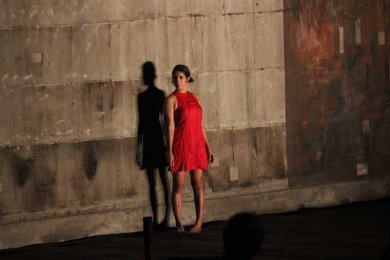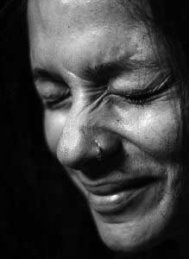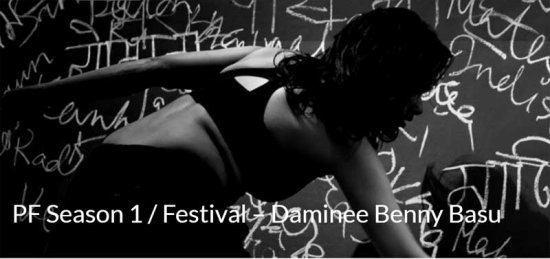
|   |

|   |
The Pickle Factory Season 1 - Riti Sharma e-mail: riti.shrma@gmail.com Photos: Indudipa Sinha / Pickle Factory Dance Foundation May 18, 2018 The Pickle Factory is a hub for the practice, presentation and discourse of dance and movement based performance in Calcutta, housed in spaces re-purposed for the arts. It is nomadic at the moment, but looking to find a permanent home in such a space in the architecturally textured fabric of Calcutta. Pickle Factory Season 1 spanned five weeks in February-March 2018 in different venues presenting performances, talks, workshops, lecture-demonstrations, dance in public spaces, exhibitions and more by artists from India and abroad. Here is a recap of the Season. The Season culminated in a week-long festival in the atmospheric Gem Cinema, featuring the work of four Indian artists - Padmini Chettur, Daminee Benny Basu, Preethi Athreya and Kapila Venu. The following is a report on this component of Pickle Factory Season 1. The Pickle Factory Dance Foundation's Opening Season was an attempt at reconnecting Kolkata's architecture with the performing arts. It began with a residency hosted by the UK based choreographer Janis Claxton, which culminated in a series of dance interventions across different locations in Kolkata (inspired by her much acclaimed work Popup Duets). Audience responses ran from mild to amused, wherein after having completed a set, the dancers were greeted with applause. Claxton's work brought back an old equation of the dancer and her space, and the result of such a dialogue that finally is laid open to a public that is completely unprepared for such an enchanting encounter.   Padmini Chettur Anticipating what was next to come would have been quite foolish, for each performer brought a different aspect of what performance is about in today's fast paced world, and how each artist has responded to the pressures, challenges and the moments of tranquility that sets apart each work. Padmini Chettur's performance Beautiful Thing 2, was an experimental take on the performing body which seeks to move beyond the old adages of prettiness and the complacency that has become a defense mechanism for young dancers. Engaging the body in not just performing for the audience's delight, but to make the audience think has been Chettur's achievement in today's performance world. Prior to the performance, Chettur's vision was disclosed to an audience at the Kolkata Centre for Creativity, wherein she described her piece Varnam, a similar deconstruction of the vocabulary of Bharatanatyam, which decries the orthodoxy prevalent in the dance form, and instead opts for an unrestricted approach to its techniques. Chettur's conversation with Trina Nileena Banerjee was an exploration into her work philosophy and how she views the world of dance from her place in the performance community.   Daminee Benny Basu Moving beyond the rigidities of dance forms, the next artist happened to question the very notion of performance and how one is able to distinguish between performance and spectacle. Daminee Benny Basu's unconventional take on the thought pattern that is activated within an audience when they come hoping for a spectacle is what one may garner from her two nights' feat, which not only aroused a social question within the audience but became a source of discomfort for many. Basu's attitude to performance was revealed during her conversation with Aveek Sen wherein she described herself as a person who shares an intimacy with the stage, having been brought up on it, whereby she ceases to differentiate between the stage and the street. Her attempt with Project Stereotype II cannot be placed within a point of view, but must be looked at as a process which unfolds in front of the audience. Basu's performance seeks to question the audience about their role in the world of performance, evoking reactions of anger, shame, complacency and discomfort. One may understand that Basu was trying to engage with a deeply unsettling reality of the current situation of Islamic society but her conceptualization could have been more sensitively tuned. Making a political comment and rejecting intolerance through angst are different ways of creating a performance piece. One may create an opinion while the other might only be to provoke an audience. While dance has been deemed as a relationship between the physical and the psychical, the notion of catharsis enables this dialogue to emerge as a reaction, understood as the audience's response as a flow of emotions. Preethi Athreya's performance over the next two days was a meditation on movement and its relation with the mind, bringing into harmony the physical and the psychical realms. The Lost Wax Project is Athreya's response to the fragmentation of the human body in an already fragmented world. Technique and rigor form the cornerstone of her compositions, but all seem to surpass expectations when the audience is confronted with a simple exercise at the beginning of the performance, that of the four dancers filling a large circle with rice flour. The futility in commemorating the body, given the title of the performance is something Athreya's dance invokes, when the finitude of the body becomes evident. Athreya's performance was not just a speculation on the division and fragility of the body but a rumination upon rhythm and its relation to existence. Harmony was the keyword in this case with the light and music arrangement suturing the performance into a quest for belief.
The experience over the last few days at Gem Cinema conveyed the many layered narrative of dance in India; that it is never stagnant or contained within an ideal but is passing through the different stages of its being. Signaling this state of impermanence that allows an art form to be a witness to the human condition, the last segment of performances was a reminder of the past, being recalled in all its glory. Kapila Venu's Koodiyattam performance Saundaryalahari was an invocation to beauty and piety. The stage for the performance was made to look like a Koothambalam, with two mizhavu players and another musician who played the shankha and edakka. The composition was taken from Adi Sankaracharya's work of the same title, which details his meeting with Shiva and subsequent events leading to his composing the Saundaryalahari, an exposition detailing the beauty of Parvati. Venu's training and approach offers any keen observer a detailed view of how subtlety and passion may be placed together in a performance space. Saundaryalahari is an account of aesthetic simplicity which shows how some of the oldest storytelling forms of the subcontinent have survived the test of time and technology. The composition ran for two hours, and held the attention of each audience member with each minute movement becoming a vehicle for expressing emotions as old as time. Earlier at a lecture demonstration at Jadavpur University, Venu conversed about the place of caste and gender that forms a part of the history of Nangiarkoothu and Koodiyattam in Kerala, placing the art form as a struggle against inequality and oppression. The first season of Pickle Factory Dance Foundation brought together reasons to celebrate dance across India and the world, while maintaining the focus on architectural spaces across Kolkata. Performers were able to translate mundane and extraordinary experiences into nonperishable moments which remain with the audience as they leave the space. However, one addition can be made into the Pickle Factory's repertory, that of having been able to transform an old, decrepit theatre hall into a site for creativity bubbling forth in the shape of young and enthusiastic volunteers, dancers and students. Such a project may indeed bring back a lost wonder that was once Kolkata's forte, to remind the people that the picture isn't over yet. Riti Sharma is currently working as a Project Fellow for a Performance Archive at the School of Media, Communications and Culture, Jadavpur University. She has completed her B.A, M.A. and M.Phil in Comparative Literature from Jadavpur University and Visva Bharati. Pickle Factory Dance Foundation: +91 9830468110 / picklefactorycalcutta@gmail.com picklefactory.in | ||||||||||